Ready to discover IPv6, the next-gen Internet Protocol (IP) that’s set to replace IPv4? This article will take you through the ins and outs of this protocol. You’ll learn what IPv6 is, including its features, structure, and packet composition.
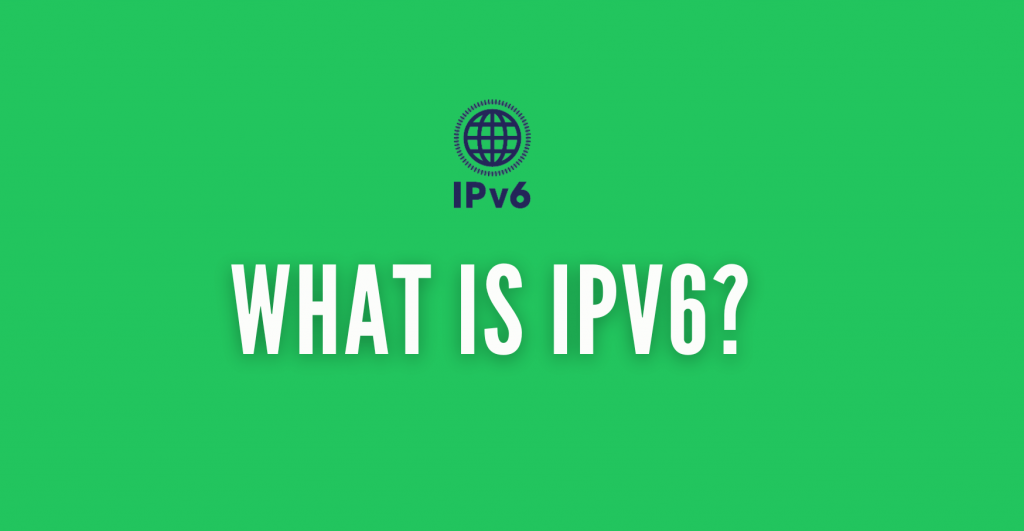
Table of Contents:
- IPv6 là gì?
- IPv6 vs IPv4: Key Differences
- IPv6 Address Structure
- Deconstructing an IPv6 Address
- IPv6 Address Types
- Structure and Composition of IPv6 Packets
- Compressing IPv6 Addresses
- IPv6 FAQ
- Lời kết
1. What is IPv6?
IPv6 (defined under RFC2460) is the updated version of the Internet Protocol known as IPv4. It was developed by the IETF in the 90s to address IPv4’s limitation on address space. It uses 128-bit addressing to significantly expand the number of possible IP addresses. The IPv6 addresses are a lot longer than IPv4 addresses. They’re 128 bits long, compared to 32 bits for IPv4. This gives the former a lot more possible addresses.
This addressing expansion is necessary because the Internet has grown so much and there are not enough IPv4 addresses to go around. Although IPv6 is not directly compatible with IPv4, there are transition mechanisms in place to help with the transition (see its migration benefits and techniques)
In addition to expanding address space, IPv6 also streamlines routing, expands multicast capabilities and includes provisions for security and device configuration. These addresses are written in eight groups of four hexadecimal digits and can be abbreviated for convenience. For example, such an address could be “2607:f8b0:4005:0800:0000:0000:0000:200e” which, when abbreviated, becomes “2607:f8b0:4005:800::200e”.
Sự thật thú vị! IPv6 has a 128-bit address space, which can theoretically accommodate 340 undecillion (that’s 340 followed by 36 zeros) unique IP addresses. That’s enough to assign an IP address to every microbial organism on the earth and still have addresses to spare – several times over!
2. IPv6 vs IPv4 (Key Differences)
IPv6 could assign a total of 2^128 interfaces, enabling the connection of countless devices and users in permanently active technologies. While IPv4 can assign a total of 2^32 interfaces (removing reserved addresses). Such an address spans 128 bits, divided into eight 16-bit blocks, using hexadecimal notation while IPv4 uses a dotted-decimal addressing.
IPv6 also improves IPv4 on several other aspects. It hierarchically allocates addresses, which makes routing more efficient and makes it easier to manage addresses. IPv6 assigns addresses to interfaces, acknowledging that one node can host multiple interfaces. Plus, you can allocate several addresses per interface (DHCPv6).
IPv6 also includes built-in security features like IPsec. This protocol ensures confidentiality, authentication, and data integrity. Such security enhancements were optional in IPv4.
Overall, IPv6 is designed to be better at routing, network autoconfiguration, and scalability. It’s a solid foundation for the internet’s future. For more on this topic, see the differences between both protocols.
| Characteristic | IPv4 Details | IPv6 Details |
| Bit Size | 32-bit | 128-bit |
| Address Representation | Dotted decimal notation | Colon-separated hexadecimal |
| Total Addresses | About 4.3 billion | Approx. 340 undecillion |
| Security Integration | IPsec (not mandatory) | IPsec (mandatory) |
| Configuration Method | Manual or DHCP | Stateless autoconfiguration |
| Address Diversity | Unicast, Multicast, and Broadcast | Unicast, Multicast, and Anycast |
| Network Address Translation (NAT) | Often required | Not required (due to large address space) – NAT not needed by IPv6 |
| Header Complexity | More complex header | Simplified header (improves processing) |
| Fragmentation | Handled by sender and routers | Handled by sender only (improves efficiency) |
Take the next step and embrace the change.
3. Address Structure.
IPv6 subnets work similarly to IPv4 but with hexadecimal IDs. We usually write such addresses as eight groups of four hexadecimal digits, separated by colons. For example, you might see an address like
| 2001:0db8:85a3:0000:0000:8a2e:0370:7334. |
This full address consists of 16 octets (128 bits in total). This address is written in hexadecimal and divided into 8 groups separated by colons. Each group has 4 hexadecimal digits and represents 16 bits or 2 octets.
Let us deconstruct this address:
Lưu ý: This specific address (2001:0db8:85a3:0000:0000:8a2e:0370:7334) is for documentation purposes.
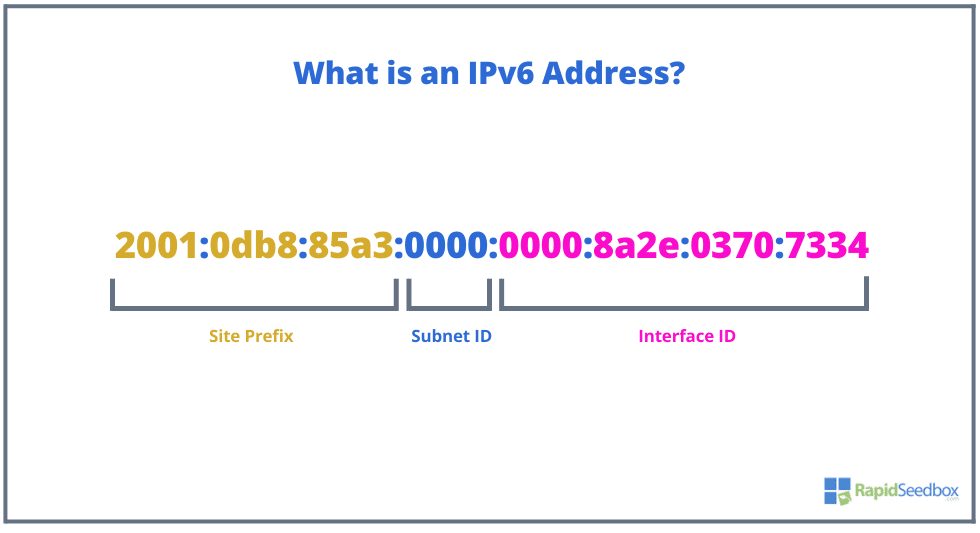
- The first 48 bits are the site prefix ( 2001:0db8:85a3). This portion indicates your public network, typically given by an ISP.
- The subsequent 16-bit block is your subnet ID (0000). This portion marks your internal network layout.
- The last 64 bits form the interface ID (0000:8a2e:0370:7334). This last portion is generated from the MAC address or set manually. Interface IDs are unique per subnet, auto-generated, or manually set (see RFC 3513 for manual settings).
Sự thật thú vị! IPv6-enabled devices can generate their own IP address as soon as they connect to a network using IPv6’s neighbor discovery protocol. This feature is also known as stateless address autoconfiguration (SLAAC).
4. Address types:
IPv6 introduces a more complex and versatile system for addressing compared to its predecessor, IPv4. It categorizes addresses into several types, each serving a distinct purpose in network communication. Understanding these address types is crucial for comprehending how it facilitates efficient and flexible internet communication.
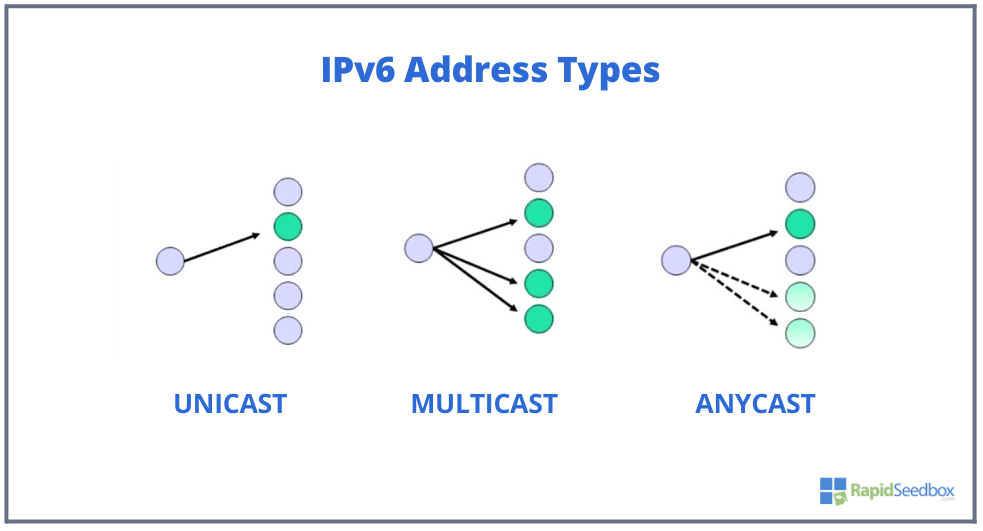
- Unicast: Links to a single node’s interface. Unicast addresses are the most common type of IPv6 address. They allow direct communication between two specific devices. There are two types of unicast addresses:
- Global unicast: Unique across the internet. For instance, the global unicast address 2001:db8:3c4d:15::/64 includes the public and private topology plus the interface ID.
- Link-local: Link-local addresses, like fe80::/10, function only within the local network (not recognized outside the network). They communicate within a single network segment. Link-local addresses are automatically configured on all interfaces.
- Multicast: Multicast addresses enable one-to-many communication. It connects to multiple interfaces, often on various nodes, distributing packets to all group members. Learn everything you need to know about this on IPv6 Multicast.
- Anycast: Anycast is a new feature (not available in IPv4). Addresses of this type are assigned to multiple interfaces (usually on different nodes). A packet sent to an anycast address is delivered to the closest interface (in terms of routing distance) that has been assigned that address.
The details for the multicast and anycast addresses are in-depth in RFC 3306 và RFC 3307
Sự thật thú vị! IPv6 doesn’t use broadcast addresses (as IPv4 does). Instead, it uses multicast and anycast addresses for communication that’s meant for multiple destinations. This reduces network traffic and improves efficiency.
Learn more about address types, from our comprehensive guide to IPv6 address types.
5. Structure and Composition of IPv6 Packets.
IPv6 packets are made up of two main parts: the header and the payload. The structure is designed to make it easy to route and handle data across the internet or other IP-based networks. For full details on IPv6 address structure, see RFC 2374.
The following image provides a visual representation of the structure and composition of IPv6 packets. The IPv6’s 40-byte header is a fixed size, allowing for simple and efficient processing by networking devices. The payload can vary in size but carries the essential data intended for the destination.
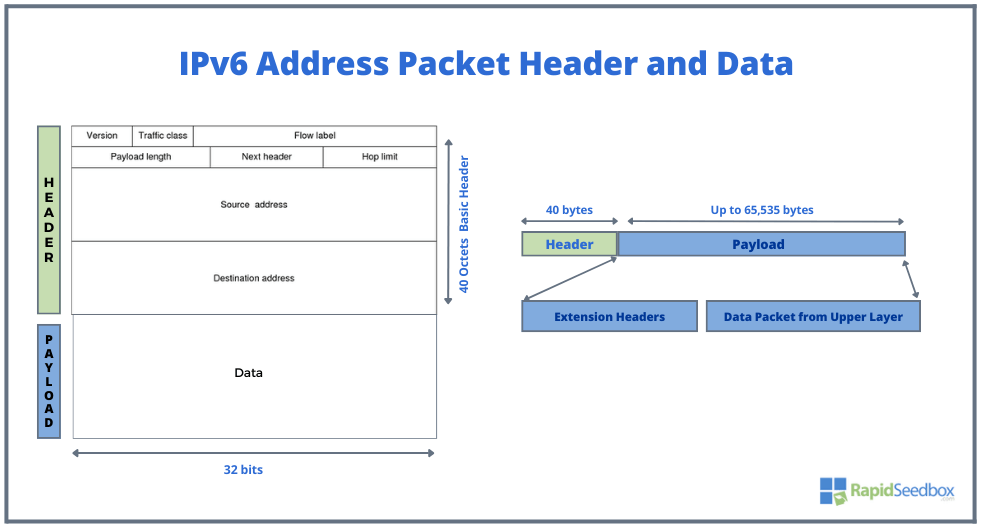
a. The IPv6 Basic Header:
IPv6 has a fixed-length 40-byte header that contains only the essential information needed for delivery.
- Version: This field indicates the version of the used IP; for IPv6, this is set to 6.
- Traffic Class: Similar to the Type of Service (ToS) in IPv4, this field is for Quality of Service (QoS) management.
- Flow Label: This labels sequences of packets that require special handling by intermediate IPv6 routers.
- Payload Length: Specifies the size of the payload in octets, including any extension headers.
- Next Header: Identifies the type of header immediately following the header and determines the interpretation of the data contained in the packet.
- Hop Limit: Replaces the Time to Live (TTL) field in IPv4, indicating the maximum number of hops (router or intermediate devices) the packet is allowed before it is discarded.
- Source Address: The 128-bit address of the originating node.
- Destination Address: The 128-bit address of the intended recipient node.
b. IPv6 Payload:
The payload comes after the header and is the part of the packet that contains the actual data. The payload can be up to 65,535 bytes, but it can be extended further with a jumbo payload option.
- Extension Headers: Optional headers that provide additional functionality, such as routing, fragmentation, and security features, are placed between the standard header and the payload.
- Data Packet from Upper Layer: This refers to the encapsulated data from higher layers of the network stack, like TCP or UDP segments, that the IPv6 packet is transporting.
Sự thật thú vị! IPv6 headers are simpler than IPv4 headers. This simplicity makes the header easier for routers to process. This is because non-essential and optional fields have been moved to extension headers that are placed after the header.
6. Compressing IPv6 Addresses
IPv6 addresses are 128 bits long, which makes them pretty long and complicated. Plus, the 128-bit long addresses can make them difficult (for humans) to use and remember. To address this issue, the protocol includes methods for address compression. These methods simplify the representation of these addresses without changing their actual value or function. This compression is essential for ease of use, especially when manually configuring IPv6 addresses and for readability.
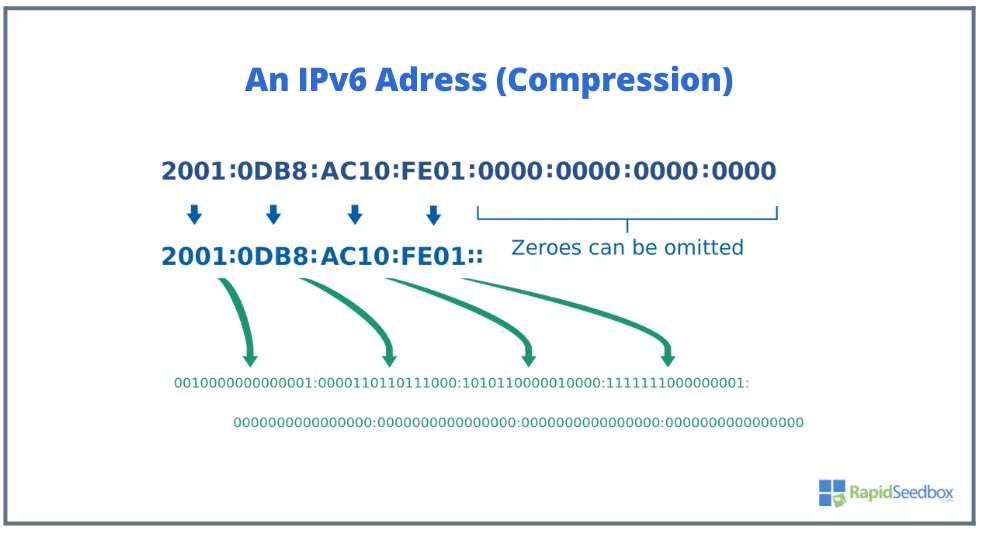
For example, IPv6 often includes fields filled with zeros. You can compress these using “::” to represent sequential zero fields (blocks of 16-bits), turning 2001:0db8:3c4d:0015:0000:0000:1a2f:1a2b into 2001:0db8:3c4d:0015::1a2f:1a2b. Note that, this zero compression method can only be used once in an address to avoid ambiguity.
The second way to compress such addresses is to drop leading zeros. In each 16-bit block, you can omit the leading zeros. For example, block 0008, can be simplified to 8. This method is often used in conjunction with zero compression.
For more on this topic, check IPv6 compression rules
7. IPv6 FAQ.
a. How to disable IPv6?
Disabling IPv6 typically involves changing the network settings on the device or within the operating system, often by unchecking IPv6 options in the network properties or modifying system configuration files. Learn how to disable IPv6 in all platforms and operating systems.
b. How many bits are in an IPv6 address?
An IPv6 address consists of 128 bits.
c. Why is NAT not needed in IPv6?
IPv6 doesn’t require NAT because it has a large enough address space to give every device a unique global address. This means that IPv6 eliminates the need to share a single public IPv4 address among multiple devices. More on Tại sao NAT không cần thiết trong IPv6?
d. Why are we currently undergoing a switch from IPv4 to IPv6?
The switch to IPv6 is primarily due to IPv4 address exhaustion; there simply aren’t enough IPv4 addresses to accommodate the growing number of internet-connected devices.
e. Which two types of IPv6 messages are used in place of ARP for address resolution?
IPv6 uses Neighbor Discovery Protocol (NDP) with two types of messages, Neighbor Solicitation and Neighbor Advertisement, in place of ARP for address resolution.
f. What is one advantage that the IPv6 simplified header offers over IPv4?
One advantage of the IPv6 simplified header is that it improves packet processing efficiency by minimizing the number of fields that routers need to check, enabling faster routing of packets.
g. How are IPv6 routing prefixes formatted?
IPv6 uses prefixes for packet routing, formatted as prefix/length in bits, like 2001:db8:3c4d::/48. Specific prefixes like 2001:db8::/32 are reserved for documentation.
h. What feature does IPv6 use to support the transition from IPv4?
IPv6 supports IPv4 address embedding to help the packets tunnel over IPv4 networks. The former also uses mechanisms like dual stack, Teredo, ISATAP, and 6to4 tunneling to make it easier to transition from IPv4 so that both protocols can coexist.
i. How to SSH to an IPv6-enabled device?
To SSH into an IPv6-enabled device, use the SSH client command followed by the username and IPv6 address, like “ssh username@[IPv6 Address]”. Ensure that the network and device both support IPv6 and the SSH service is listening on the IPv6 address. Check our comprehensive guide to SSH on IPv6
j. Why is it taking so long to switch from IPv4 addresses over to IPv6?
The switch from IPv4 to the newer protocol is taking a while because of the huge infrastructure built around IPv4. Plus, there is still a massive need for IPv6 to be compatible with devices and networks. Additionally, the existence of temporary solutions like NAT has reduced the urgency for some organizations to make the switch. More of this topic on why is it taking so long to switch from IPv4 addresses over to IPv6.
8. Lời kết.
IPv6 is not just the future, it’s already here to change how we connect across the globe. It has virtually unlimited address space and enhanced features that overcome the limitations of IPv4, setting a new standard for internet communication.
Get on board with the change, understand the benefits, and prepare for a smooth transition with our detailed insights. We hope this article helped you understand what IPv6 is.
01 bình luận